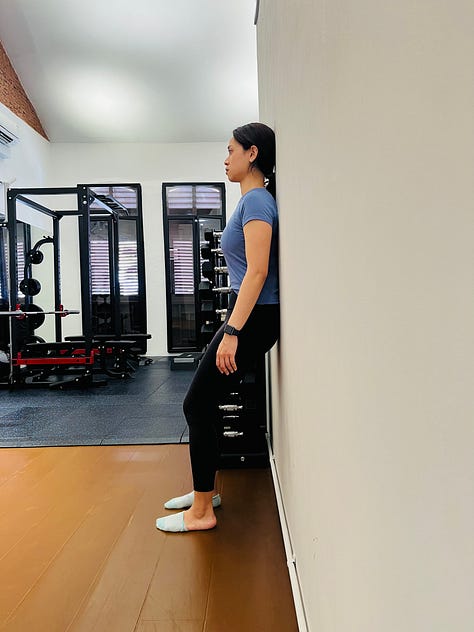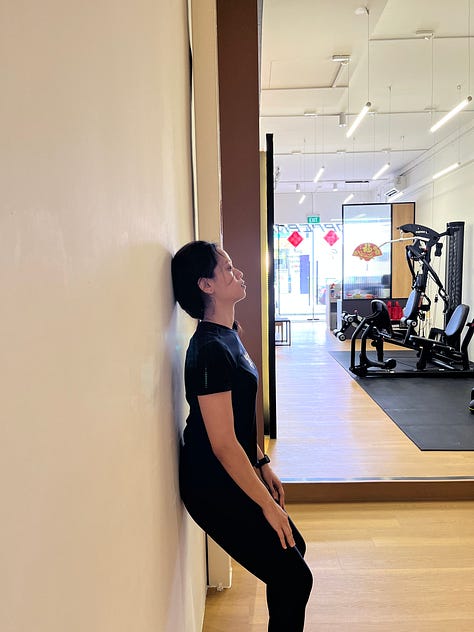Climber’s Posture: Is the Hunch Holding You Back?
Rounded back and forward shoulders — it's the dreaded 'climber's hunch'. Is it affecting performance, and should you be concerned? Physiotherapist Sarita Mok puts it in perspective.
Ahhh, the classic ‘climber’s posture.’ You have probably seen it — the rounded back, and forward shoulders, whether you are belaying a friend or watching them on the wall. This hunched posture is not exclusive to climbers; we sometimes see it in desk workers too. Climbers however, despite being physically active, often find themselves in this posture both on and off the wall.
Should you be concerned?
Let’s start with this: Posture is not inherently good or bad. Research increasingly shows that there is no perfect posture — plenty of people move and function well despite having what might seem like ‘poor’ posture. To set the record straight, the point of this is not to instil fear, self-consciousness, or overthinking.
That said, there is a performance angle that climbers could consider, particularly concerning mid-back (thoracic) mobility.
Why Do Climbers Hunch?
Climbing is a pull-dominant activity. As climbers, we are constantly using muscles like our lats and pecs to bring ourselves closer to the wall. Once we are off the wall, the body naturally wants to rest and recover; slouching often feels like the easiest way to offload the neck and upper back muscles.
Now, here is the thing about slouching: If we’re only doing it occasionally, that’s totally fine!
But sustained slouching over time? That is when we may start to notice changes in shoulder position, tension, and eventually, causing the rounded shoulder and hunched posture.
Why Mid-Back Mobility Matters in Climbing
In climbing, when we reach overhead for the next hold or when hanging, our shoulders do not work alone. A certain amount of movement through the mid-back (thoracic spine) naturally happens to support that action. If this mobility is limited in our mid-back, our shoulders compensate, which can affect:
How confidently we reach or hang
Shoulder joint health
Long-term climbing performance
What Limits Thoracic Mobility or Thoracic Extension?
Tight muscles: Overactive pecs and lats can pull the shoulders forward
Weak muscles: Underactive mid-back muscles like the middle and lower traps causing rounder shoulders
Quick Self-Test: How is Your Mid-Back Mobility?
Try the Occiput-to-Wall Test! It is a simple test to check if your thoracic spine is holding you back from performing better.
Position your feet about 1 foot away from the wall.
Lean your back against the wall. Ensure your lower back is not arched — you should not be able to slide your hand between your lower back and the wall. If you are able to slide your hand in, tilt your pelvis back to flatten your back against the wall.
Bend your knees slightly into a quarter squat position.
Bring the back of your head (occiput) to touch the wall.



What to look out for:
If you cannot bring your head back without tilting it upward (i.e. looking at the ceiling)
If you feel your lower back arching to compensate
then you likely have limited thoracic mobility.
But don't worry! This is simply a starting point to identify stiffness and begin working on improving mobility.
What can you do about it?
Improving posture and mobility is about consistency over time. While there is no perfect formula, many climbers benefit from working on a few key areas: Stretching tight muscles like the chest and lats; strengthening the mid-back to support better shoulder function; and addressing the neck, especially if you tend to stay in a forward-head posture for long periods i.e. if you are working on a computer or using your mobile device.
Take It One Step at a Time
It must be emphasised, as physiotherapists we are not trying to ‘fix’ you. Our goal is to give your body the tools in order to move better and climb stronger. Undoing months (or years) of habitual posture takes time, but with steady effort, even small changes can make a big difference.
And if you are already thinking this sounds familiar to our philosophy at One Percent Rehab, you are right! It is about being 1% better every day.
References:
• Smythe, A., & Jivanjee, M. (2021). The straight and narrow of posture: Current clinical concepts. Australian Journal of General Practice, 50(11), 807–810. https://doi.org/10.31128/ajgp-07-21-6083
• Stewart, S.G.; Jull, G.A.; Ng, J.K.F.; Willems, J.M. An initial analysis of thoracic spine movement during unilateral arm elevation. J. Man. Manip. Ther. 1995, 3, 15–20.
• Howe, Louis & Read, Paul. (2015). Thoracic spine function: assessment and self-management. Strength and Conditioning.
Sarita Mok is a regular climber at BM and a physiotherapist at BM’s official physio partner One Percent Physio & Rehab. One Percent is located at 142 Joo Chiat Road, Singapore 427422, tel: 8767 0973.






